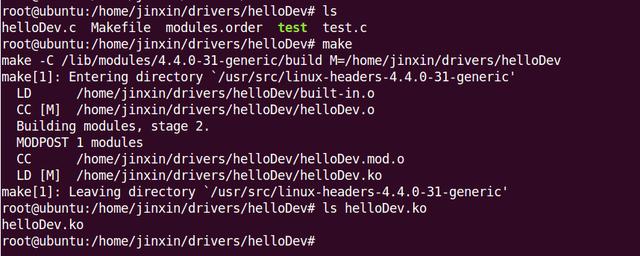關(guān)注“技術(shù)簡說”,一步一步教你開發(fā)linux內(nèi)核和驅(qū)動
hello world!是廣大程序員入門一門新語言的第一步。
今天,我們來看一個hello驅(qū)動,希望這是大家入門linux內(nèi)核驅(qū)動的良好開局。
我的環(huán)境是ubuntu 14.04,內(nèi)核版本 4.4.0-31-generic,本節(jié)我會開發(fā)一個基于ubuntu 14.04下的最簡單的hello驅(qū)動,帶大家領(lǐng)略驅(qū)動的魅力。
開發(fā)linux內(nèi)核驅(qū)動需要以下4個步驟:
- 編寫hello驅(qū)動代碼
- 編寫makefile
- 編譯和加載hello驅(qū)動
- 編寫應(yīng)用程序測試hello驅(qū)動

驅(qū)動代碼如下 helloDev.c,這是一個最小、最簡單的驅(qū)動,我去掉了其他的不相干代碼,盡量讓大家能了解驅(qū)動本身。
#include <linux/module.h>
#include <linux/moduleparam.h>
#include <linux/cdev.h>
#include <linux/fs.h>
#include <linux/wait.h>
#include <linux/poll.h>
#include <linux/sched.h>
#include <linux/slab.h>
#define BUFFER_MAX (10)
#define OK (0)
#define ERROR (-1)
struct cdev *gDev;
struct file_operations *gFile;
dev_t devNum;
unsigned int subDevNum = 1;
int reg_major = 232;
int reg_minor = 0;
char *buffer;
int flag = 0;
int hello_open(struct inode *p, struct file *f)
{
printk(KERN_EMERG"hello_openrn");
return 0;
}
ssize_t hello_write(struct file *f, const char __user *u, size_t s, loff_t *l)
{
printk(KERN_EMERG"hello_writern");
return 0;
}
ssize_t hello_read(struct file *f, char __user *u, size_t s, loff_t *l)
{
printk(KERN_EMERG"hello_readrn");
return 0;
}
int hello_init(void)
{
devNum = MKDEV(reg_major, reg_minor);
if(OK == register_chrdev_region(devNum, subDevNum, "helloworld")){
printk(KERN_EMERG"register_chrdev_region ok n");
}else {
printk(KERN_EMERG"register_chrdev_region error n");
return ERROR;
}
printk(KERN_EMERG" hello driver init n");
gDev = kzalloc(sizeof(struct cdev), GFP_KERNEL);
gFile = kzalloc(sizeof(struct file_operations), GFP_KERNEL);
gFile->open = hello_open;
gFile->read = hello_read;
gFile->write = hello_write;
gFile->owner = THIS_MODULE;
cdev_init(gDev, gFile);
cdev_add(gDev, devNum, 3);
return 0;
}
void __exit hello_exit(void)
{
cdev_del(gDev);
unregister_chrdev_region(devNum, subDevNum);
return;
}
module_init(hello_init);
module_exit(hello_exit);
MODULE_LICENSE("GPL");
有了驅(qū)動文件之后,我們還需要一個Makefile才能把驅(qū)動編譯出來:
ifneq ($(KERNELRELEASE),)
obj-m := helloDev.o
else
PWD := $(shell pwd)
KDIR:= /lib/modules/4.4.0-31-generic/build
#KDIR := /lib/modules/`uname -r`/build
all:
make -C $(KDIR) M=$(PWD)
clean:
rm -rf *.o *.ko *.mod.c *.symvers *.c~ *~
endif
linux應(yīng)用層程序在編譯的時候,需要鏈接c運(yùn)行時庫和glibc庫。那驅(qū)動需不需要呢?
驅(qū)動也需要,但是驅(qū)動不能鏈接和使用應(yīng)用層的任何lib庫,驅(qū)動需要引用內(nèi)核的頭文件和函數(shù)。所以,編譯的時候需要指定內(nèi)核源碼的地址。為了開發(fā)方便,也可以安裝內(nèi)核開發(fā)包,之后引用這個內(nèi)核開發(fā)包的目錄也可以。本例為:/lib/modules/4.4.0-31-generic/build

驅(qū)動文件和Makefile都有了,那么接下來就可以編譯和加載驅(qū)動了!
在驅(qū)動目錄下,執(zhí)行make進(jìn)行編譯:

編譯出來的驅(qū)動文件,名稱為:helloDev.ko
接下來把這個驅(qū)動加載到內(nèi)核:

helloDriver加載成功,打印出了:
[11837.379638] register_chrdev_region ok
[11837.379642] hello driver init
可見,執(zhí)行insmod的時候,驅(qū)動文件里的hello_init被調(diào)用了。
那驅(qū)動文件里的hello_exit什么時候會被調(diào)用呢?
可能聰明的你已經(jīng)猜到了,那就是執(zhí)行 rmmod helloDev.ko的時候。

本節(jié)來看驅(qū)動的測試。
我們需要編寫一個應(yīng)用層的程序來對hello驅(qū)動進(jìn)行測試:(test.c)
#include <fcntl.h>
#include <stdio.h>
#include <string.h>
#include <sys/select.h>
#define DATA_NUM (64)
int main(int argc, char *argv[])
{
int fd, i;
int r_len, w_len;
fd_set fdset;
char buf[DATA_NUM]="hello world";
memset(buf,0,DATA_NUM);
fd = open("/dev/hello", O_RDWR);
printf("%drn",fd);
if(-1 == fd) {
perror("open file errorrn");
return -1;
}
else {
printf("open successern");
}
w_len = write(fd,buf, DATA_NUM);
r_len = read(fd, buf, DATA_NUM);
printf("%d %drn", w_len, r_len);
printf("%srn",buf);
return 0;
}
編譯并執(zhí)行,發(fā)現(xiàn)錯誤,找不到設(shè)備文件:

這是因為還沒有創(chuàng)建hello驅(qū)動的設(shè)備文件,我們?yōu)閔ello驅(qū)動手動創(chuàng)建設(shè)備文件:
root@ubuntu:/home/jinxin/drivers/helloDev# mknod /dev/hello c 232 0
備注:這里的232和0要跟驅(qū)動文件里定義的主次設(shè)備號對應(yīng)起來!
然后再次執(zhí)行測試程序,發(fā)現(xiàn)成功了:
root@ubuntu:/home/jinxin/drivers/helloDev# ./test
3
open successe
0 0
root@ubuntu:/home/jinxin/drivers/helloDev#
然后再次執(zhí)行dmesg查看驅(qū)動輸出,發(fā)現(xiàn)驅(qū)動里的hell_open, hello_write, hello_read被依次調(diào)用了。

這就是一個完整的、最簡單的驅(qū)動的開發(fā)和測試的流程。
我想大家可能會有幾個問題:
1.驅(qū)動測試的時候為什么要有設(shè)備文件,設(shè)備文件的作用是什么?hello驅(qū)動的設(shè)備文件創(chuàng)建的時候為什么要指定主設(shè)備號為232, 此設(shè)備號為0?
2.對/dev/hello執(zhí)行write()調(diào)用的時候,怎么就調(diào)用到了驅(qū)動里的hello_write()里去了?
3.驅(qū)動代碼里的register_chrdev_region這些函數(shù)都是干什么的?實現(xiàn)的地方在哪里?
4.測試程序的read和write的返回值為什么都是0?
針對以上可能的問題,敬請期待《linux內(nèi)核驅(qū)動第2講》,我會一一回答以上問題。
關(guān)注“技術(shù)簡說”,一步一步教你開發(fā)linux內(nèi)核和驅(qū)動






